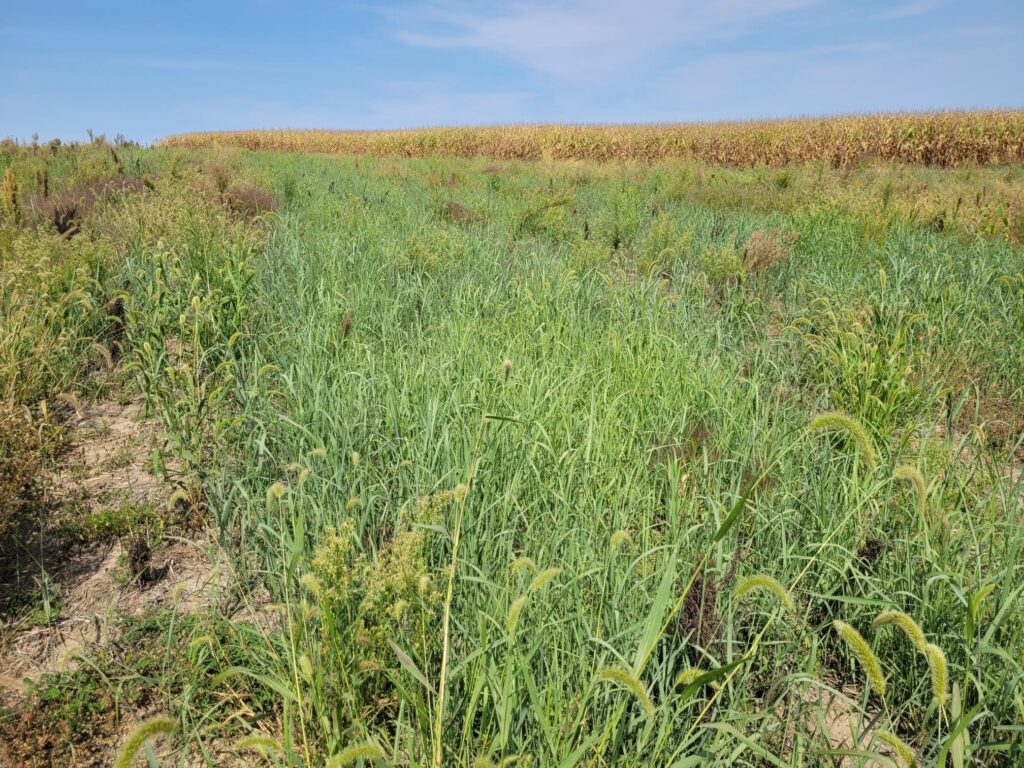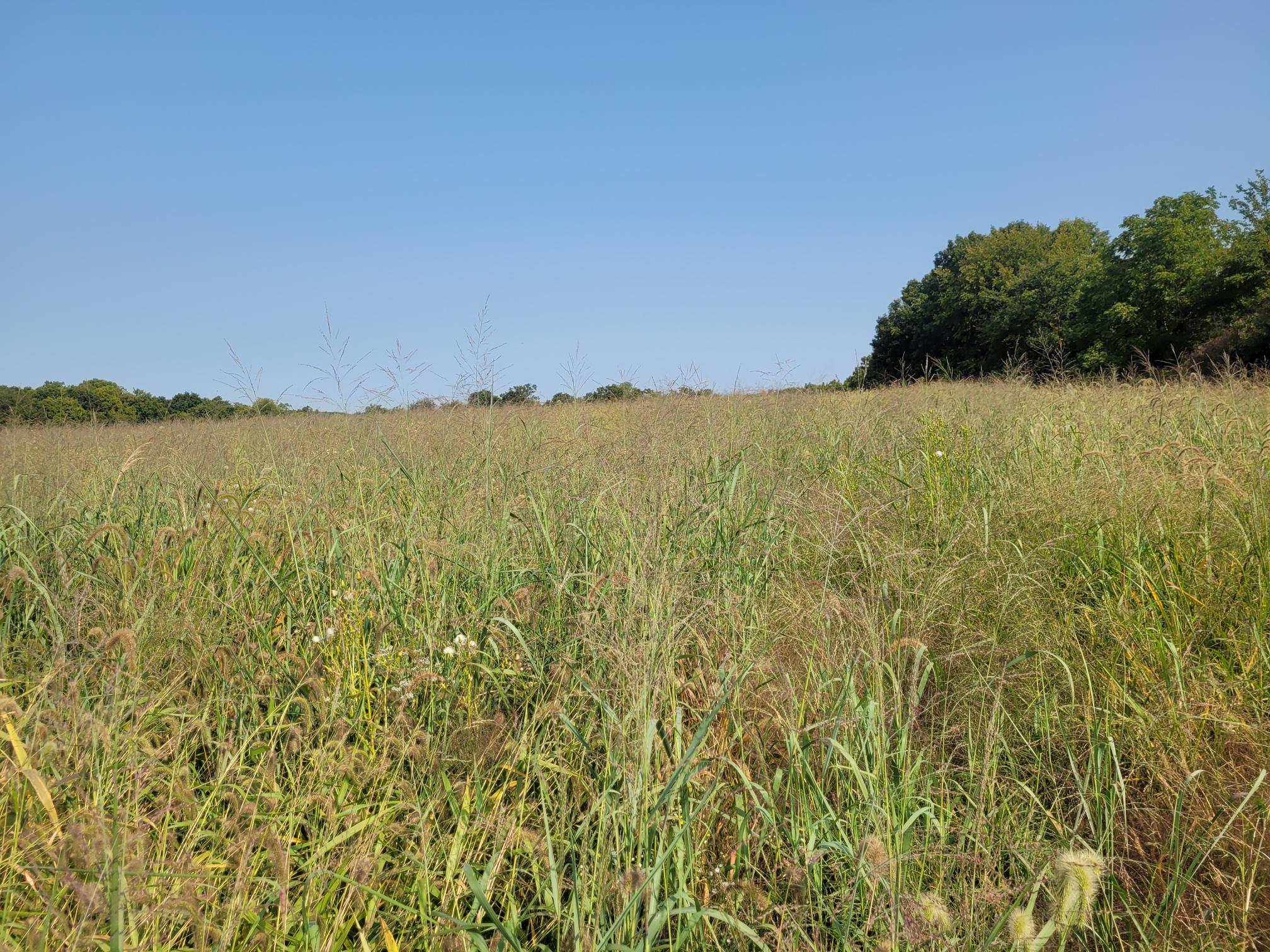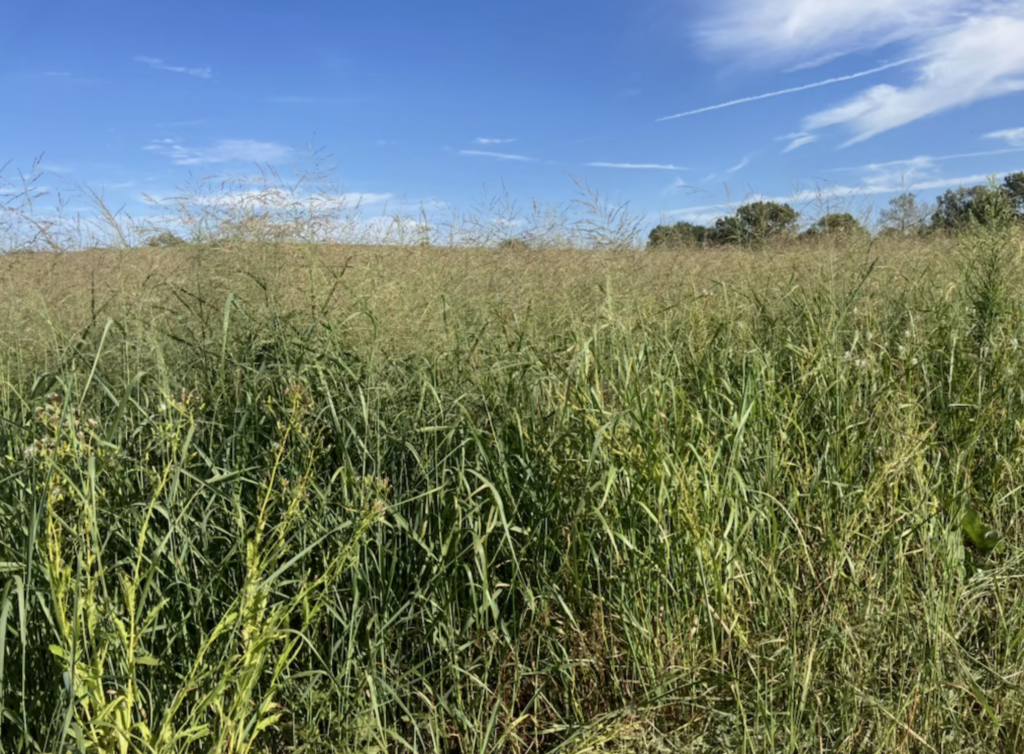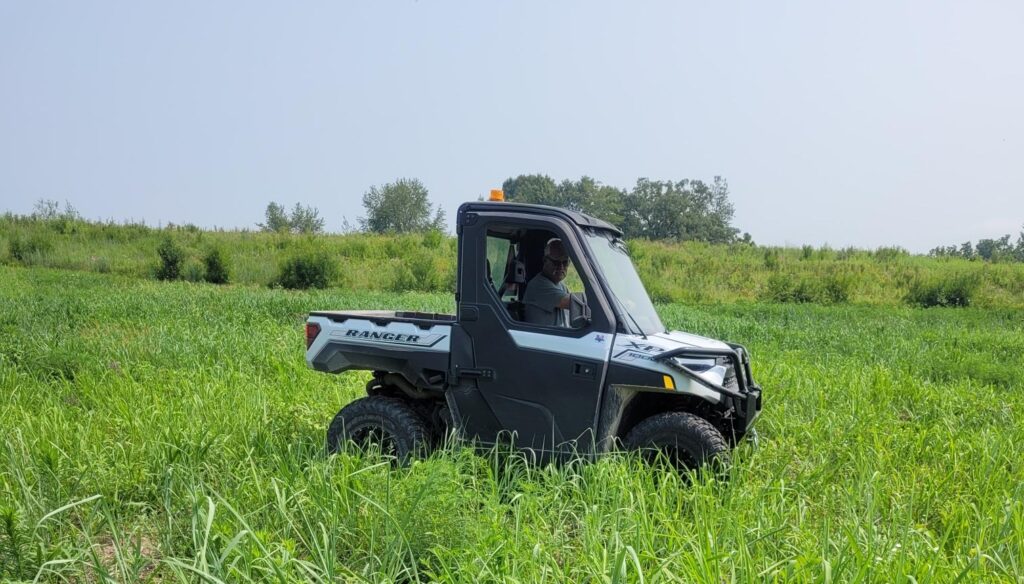Switchgrass, when properly managed, reduces soil erosion, improves water quality, increases water penetration throughout the soil profile, improves nutrient management, increases soil carbon, provides for greater biodiversity and can improve net farm income with less management requirements. Read on to learn more details.
Reduce erosion
When soil erodes, it carries phosphorus (P), which attaches to soil particles and enhances algae bloom in rivers, streams, and bodies of water. It renders those waters poor for human consumption, swimming, and fish and aquatic habitat.
“Around 5.2 million tons of sediment enter the Chesapeake Bay in an average year.”
— Chesapeake Bay Program
EROSION
How switchgrass reduces erosion
Switchgrass — a warm-season, native perennial grass — has a deep growing, massive fibrous root system.
- Above ground, switchgrass minimizes exposed soil by holding firm to the soil.
- Above ground, switchgrass is stiff-stemmed. It intercepts rainfall and resists overland water flow.
- Under ground, the switchgrass root system is an intricate web of porous channels, which promotes water infiltration on site.
Slowing down the water and allowing it to penetrate the soil profile lessens the impact to neighbors downstream and to the infrastructure servicing those areas.
Improve water quality
“Integrating small amounts of prairie into strategic locations within corn and soybean fields — in the form of in-field contour buffer strips and edge-of-field filter strips — can yield disproportionate benefits for soil, water, and biodiversity.”
Iowa State University
Nitrogen loading reductions could occur if maize is replaced by switchgrass because switchgrass uses nitrogen much more efficiently than maize. Switchgrass has extensive root systems during all seasons that take up mineral nitrogen and store it in plant tissues. Thus, perennial crops such as switchgrass lose much less nitrogen to the environment, including leaching to streams and rivers.

How switchgrass improves water quality
Having perennial grass strips or plantings of switchgrass across the landscape slows down water during intense rain events. Reducing the speed of the water runoff allows fine soil particles to stay within the grassy areas and reduces the turbidity in rivers and streams.
Switchgrass stands act like filter buffers. Some of the phosphorus and suspended nitrogen carried by soil and the water from the eroded areas of a field is utilized by the growing switchgrass.
Learn more: Biomass Production with Conservation Practices for Two Iowa Watersheds
Improve nutrient management
“The largest source of pollution to the Bay comes from agricultural runoff, which contributes roughly 60 percent of the nitrogen and 45 percent of the phosphorus entering the Chesapeake Bay.”
— Chesapeake Bay Foundation

Deep-rooted perennial grasses like switchgrass survive in most all Virginia soils. Switchgrass can flourish and grow in wet or dry conditions and grows rapidly in warmer growing conditions.
Current research validates that having a cover crop on the landscape for the entire year reduces nitrogen leaching, reduces soil erosion and allows more nutrients to be available for the next growing season.
How switchgrass improves nutrient management
By converting non profitable acres on a farm, the grower reduces crop inputs on those acres which offer little financial return or leach or erode into rivers and streams.
In many instances, little or no nitrogen amendments are required for the growing switchgrass plant because nitrogen is derived by the degradation of small root fibers within the root mass. The soil fungi and other microorganisms produce nitrogen which are taken up as the plant starts to regrow in the spring.
The nutrients and micronutrients which translocate back to the root after a killing frost are available for the next growing season, making switchgrass a great plant to recycle nutrients during the next growing season.
Build soil carbon
Researchers found that switchgrass — whether used in streamside buffers or as a cash crop — stores harmful carbon at a level similar to trees and better than land planted with other native grasses.
Source: bayjournal.com
Soil carbon or soil organic matter is the real workhorse of our productive soils in Virginia. We have lost nearly half of our deep rich soils since we broke the prairie with the moldboard plow. Those losses have occurred through the destruction of soil aggregate structure, as well as wind and soil erosion. We can rebuild soil in future decades using modern farm practices like no-till planting and establishment of perennial grasses like switchgrass.
Research studies like “Management controls the net greenhouse gas outcomes of growing bioenergy feedstocks on marginally productive croplands” validate the environmental improvements which can be achieved by planting switchgrass strategically within a corn/soybean crop rotation landscape.

How switchgrass builds soil carbon
Perennial systems eliminate the impact of tillage operations over annual systems where there is carbon flux with annual tillage operations. Perennial cropping systems maintain or increase soil organic carbon (SOC) over time vs. corn and soybean production.
Because switchgrass has a deep fibrous root system which translocate carbon depositions several feet into the soil, above ground material can be periodically removed and yet maintain a net positive of carbon capture below ground. Also, as those roots die and regenerate over the production life of the crop, soil porosity and carbon content is found deeper in the soil profile.
Boost farm revenue and return on ROI
Net farm income is forecast at $140 billion for 2024, marking a $6.5 billion decline from 2023. This follows a sharp 19.5% drop from 2022 to 2023. Inflation-adjusted figures indicate even greater financial strain.
Source: American Farm Bureau Federation
When you enroll into the “Virginia Climate Smart Switchgrass Cropping System,” on your marginal producing cropland acres, the FDCE team is responsible for the workload and costs associated with planning, seeding, stand maintenance and harvesting of the switchgrass. The project team will utilize the latest best management practices, purchase the seed, install the seed on the designated areas, do weed pest management and harvest your material making it market ready at no cost to you the landowner/producer.
After receiving 2 years of USDA soil rental rate for the designated areas, you will receive a contract for the material harvested from your acres, essentially giving you a net positive return on those acres.
You – the landowner/grower – have opportunity to make a positive return on investment (ROI). Planting switchgrass on marginal acres can, at a minimum, improve your net revenue stream and eliminate concerns to make “break evens” on inputs. This can come from reducing crop insurance rates and decreasing input costs of fertilizer and pesticides on those areas of the field. FDCE team is working on developing and providing market opportunities for the production from the switchgrass converted acres. This project affords landowners to produce a renewable biomass crop for a market and diversify the crop production income from their farm. This program shoulders the production and financial risk on those acres converting to a switchgrass crop during the initial two years of establishment. Afterwards, switchgrass, provides a revenue stream from biomass harvest.

How RCPP boosts farm revenue
Planting switchgrass on marginal acres can, at a minimum, improve the ROI to a positive value proposition offered by this switchgrass production system.
By producing a renewable biomass crop for a market, farmers/landowners can reduce their production and financial risk on acres that they convert to switchgrass. This can come from reducing crop insurance rates and decreasing input costs of fertilizer and pesticides on those areas of the field.
If strategically placed on the landscape of the farm to capture run off, a farmer/landowner can utilize those nutrients to improve the nitrogen mass balance and build soil carbon, adding value to entire land base asset.
Boost rural communities and economies
“Sustainable agriculture is essential for improving rural economies and remediating environmental challenges like air, water, and soil pollution. Perennial bioenergy grasses can be one of the approaches to improve water and soil quality and increase farmer profits on lower yielding parts of the land.“
— Veronika Vazhnik, PhD, Penn State University
Utilizing the “Virginia Climate Smart Switchgrass Cropping System,” as part of your farm management strategy will improve the environmental output from your acres, improve the income potential from those marginal producing acres and provide habitat for wildlife in your area.
This project has the potential to improve the net income of your entire farm by converting marginal producing acres into a more profitable production system. This also can reduce the weather risk on your farm.
Utilizing a perennial switchgrass cropping system is a part of the overall climate smart strategy now being promoted within the USDA.
How RCPP boosts rural communities and economies
Planting switchgrass strategically on the landscape on marginal acres can slow water moving across the terrain during flooding events and help preserve infrastructure in a local area. Reducing the impact of heavy rains save all property taxpayers in a county or city in Virginia preserving roads, water corridors and even areas of cities and towns which are prone to flooding.
Utilizing a commercial perennial cropping system offers diversity to current agriculture corn/soybean production which minimizes risk on marginal producing crop acres. Switchgrass acres should require less chemical and nutritional inputs over the productive life of the stand reducing financial risk on those acres.
This RCPP switchgrass production practice reduces risk and cash outlays to farmers/landowners which could aid beginning farmers by optimizing their equipment outlay and operating risks as they start farming. It can also afford retiring farmers reduced risks as they end their farming careers and transition to historically under-served farmers.






